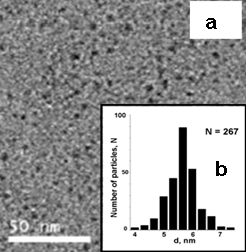Smaller nanoparticles for a more efficient catalyst

The Biginelli reaction is an organic cyclocondensation whose products are widely used in the pharmaceutical industry as calcium channel blockers, antihypertensive agents, mitotic kinase inhibitors and antiviral agents among applications. The speed of this reaction is increased by iron and copper catalysts. The surface of these catalysts is where reaction occurs, so their efficiency directly depends on their smaller size and how disperse they are, avoiding conglomerations. In this research, scientists have managed to create catalyst nanoparticles around 5nm insize, which need only 2h for the reaction (instead of the usual 18h) and use 30 times less catalyst than the ordinary method.
During the last decade, the multicomponent reactions have become increasingly important in the organic and medicinal chemistry as efficient and low-cost tool for the combinatorial synthesis. The Biginelli reaction is typically a Lewis acid-catalyzed three-component cyclocondensation of an aldehyde, a β-ketoester and urea, which results in the formation of various dihydropyrimidones (see Scheme 1). These compounds are widely used in the pharmaceutical industry as calcium channel blockers, antihypertensive agents, mitotic kinase inhibitors and antiviral agents among applications.
In this presentation we report the results obtained by the synthesis and characterization of μ3-oxo-bridged clusters containing {Fe2CuO} core as precursors for the preparation of more efficient nanosized catalytic systems for the Biginelli reactions operating at a lower catalyst concentration. The monodisperse nanoparticles of iron and copper oxides soluble in the organic solvents were obtained by the thermal decomposition of clusters [Fe2CuO(CCl3COO)6(THF)3] and [Fe2CuO(CCl3COO)6(4-DMAP)3] in 1-hexadecylamine (HDA) under argon atmosphere (THF = tetrahydrofuran, and 4-DMAP = 4-dimethylaminopyridine).
The TEM analysis of the decomposition products showed that the best results were obtained in the case of [Fe2CuO(CCl3COO)6(4-DMAP)3] decomposition. The nanoparticles of the resulting product are round shaped and are homogeneously distributed by sizes and with particle diameters ranging from 4 to 7 nm (see Fig. 1). As follows from the particle distribution histogram, an average particle diameter is about 5.65 nm.
We examined the Biginelli solvent-free reaction of ethyl acetoacetate with aromatic aldehydes and urea in the presence of γ-Fe2O3-CuO catalyst nanoparticles at 105-120ºC (Scheme 1).The reaction led to the formation of 3,4-dihydropyrimidin-2-(1H)-ones 5a-c which were formed at different yields. It has been shown that the nature of the catalyst and that of the initial aldehyde significantly influence the reaction rate and the product yield. Under these novel conditions, the reaction time was significantly shortened from 18 h of the classical Biginelli method to 2 h, and the concentration of catalyst was decreased by more than 30 times: from 0.6–5.0 mol% to 0.02 mol%.
References
"Synthesis and characterization of {Fe2CuO} clusters as precursors for nanosized catalytic system for Biginelli reaction". D. Prodius, F. Macaev, V. Mereacre, S. Shova, Y. Lutsenco, E. Styngach, P. Ruiz, D. Muraviev, J. Lipkowski, Y. A. Simonov, C. Turta. Inorganic Chemistry Communications, 12, 642-645 (2009).

